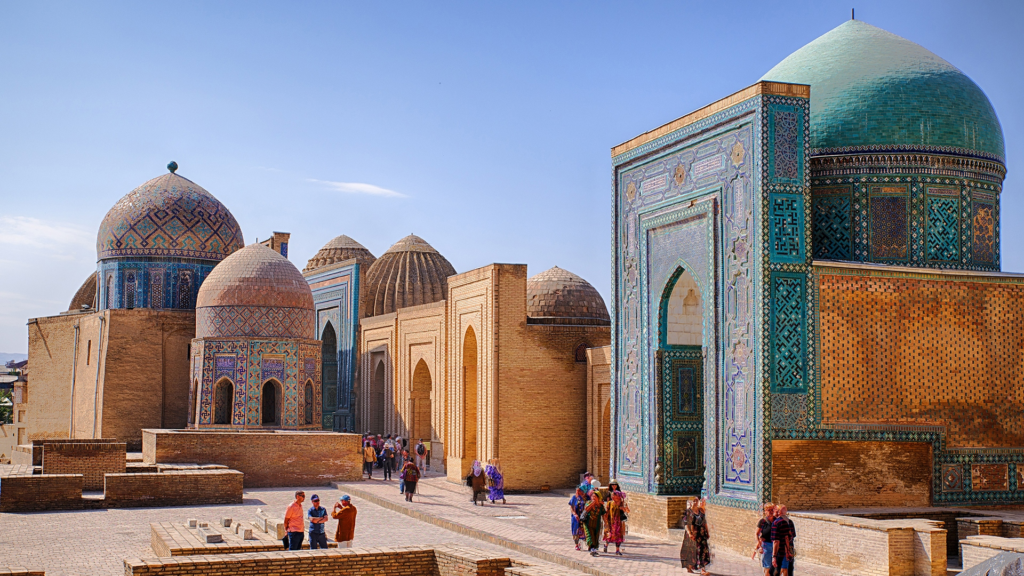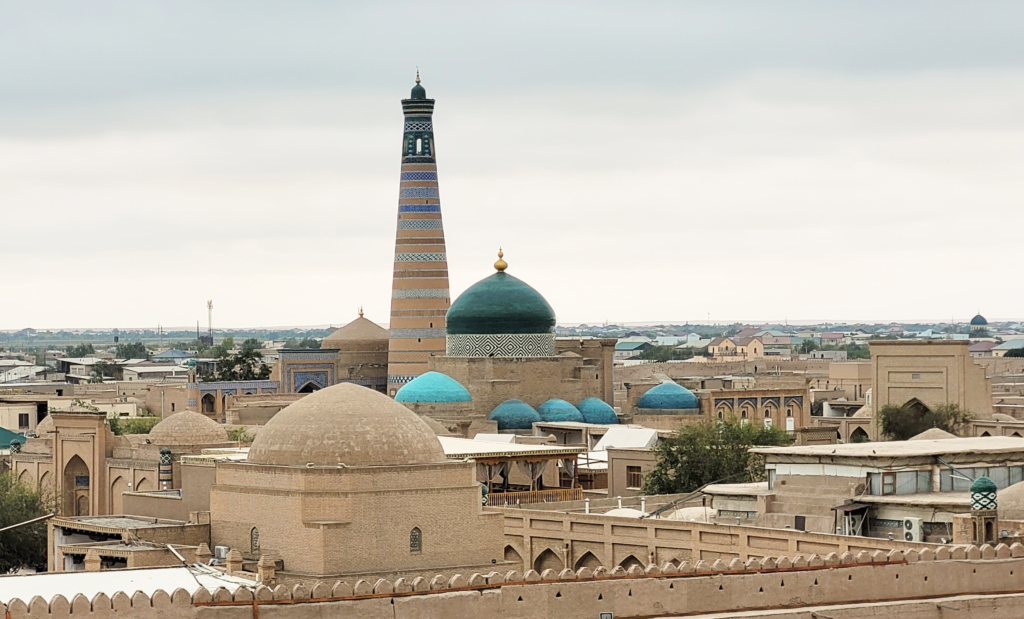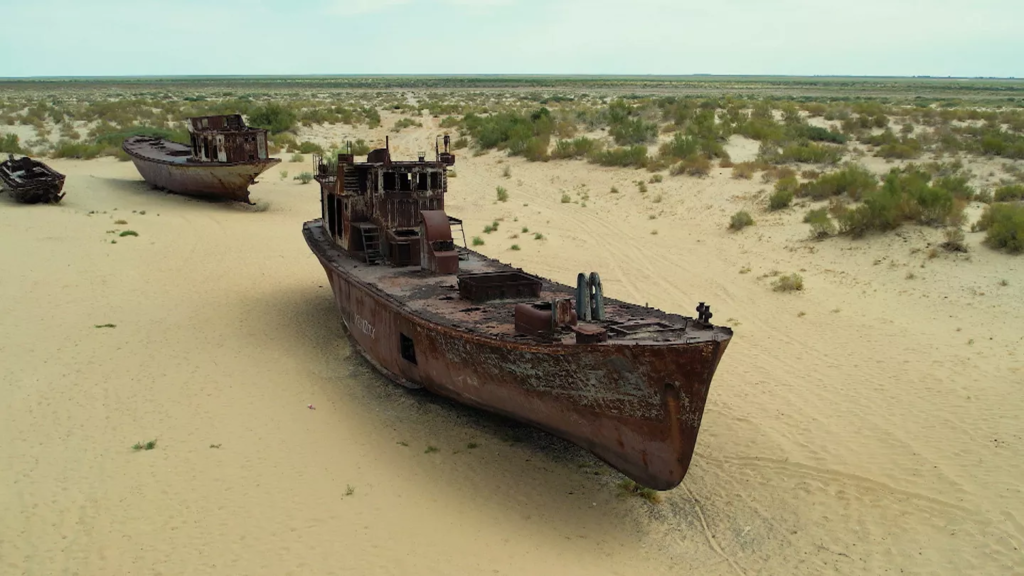Uzbekistan, located in the heart of Central Asia, is a land rich in history, culture, and natural beauty. It has a diverse landscape that includes deserts, mountains, and fertile valleys. Uzbekistan is bordered by Kazakhstan to the northwest and north, Kyrgyzstan to the northeast, Tajikistan to the southeast, Afghanistan to the south, and Turkmenistan to the southwest. Covering an area of 447,400 square kilometers, Uzbekistan is the 56th largest country in the world and has a population of approximately 34 million people.
Table of Contents
Geography
Uzbekistan is a double landlocked country, meaning it is surrounded by landlocked countries on all sides. The country’s landscape is dominated by the Kyzylkum Desert to the north and the Karakum Desert to the west, while the eastern part is home to the fertile Fergana Valley. The Pamir and Tian Shan mountain ranges provide a dramatic backdrop to the east and southeast. The Syr Darya and Amu Darya are the two major rivers that traverse Uzbekistan, contributing to its agricultural productivity.
The climate of Uzbekistan is continental, characterized by hot summers and cold winters. Temperatures can soar above 40°C (104°F) in summer, while in winter, they can drop below freezing. Despite its arid environment, Uzbekistan has been able to develop a thriving agricultural sector, particularly in cotton production, which remains a significant part of the economy.
States of Uzbekistan
Uzbekistan is divided into 12 regions (viloyatlar), one autonomous republic (Karakalpakstan), and the capital city, Tashkent, which is a separate administrative unit. The 12 regions are:
| Number | Region |
|---|---|
| 1 | Andijan |
| 2 | Bukhara |
| 3 | Fergana |
| 4 | Jizzakh |
| 5 | Kashkadarya |
| 6 | Navoi |
| 7 | Samarkand |
| 8 | Sirdaryo |
| 9 | Surxondaryo |
| 10 | Tashkent Region |
| 11 | Khorezm |
| 12 | Namangan |
A Glimpse into History
Uzbekistan’s history is a tapestry woven with threads of ancient civilizations, conquests, and empires. The region was a vital part of the Silk Road, the ancient trade route that connected the East and West. It facilitated the exchange of goods, ideas, and culture, making Uzbekistan a melting pot of civilizations.
The most significant period in Uzbek history dates back to the time of the Persian Empire and the subsequent conquests by Alexander the Great. However, it was during the reign of the Timurid Empire in the 14th and 15th centuries, under the leadership of Timur (Tamerlane), that Uzbekistan reached its zenith. The empire’s capital, Samarkand, became a center of science, culture, and Islamic scholarship, attracting scholars and artisans from across the world.
Cultural Heritage
Uzbekistan’s cultural heritage is immensely rich and diverse. The country is home to three of the most famous Silk Road cities: Samarkand, Bukhara, and Khiva. These cities are renowned for their stunning Islamic architecture, including intricate tile work, grandiose mosques, and magnificent madrasahs.
Samarkand, often referred to as the “Crossroad of Cultures,” is famous for the Registan Square, a masterpiece of Islamic architecture. The square is flanked by three grand madrasahs, each adorned with stunning mosaics and blue-tiled domes. Bukhara, another ancient city, boasts over 140 architectural monuments, including the iconic Kalyan Minaret and the Ark Fortress. Khiva, a well-preserved open-air museum, showcases the traditional khanate architecture with its Ichan Kala inner city, surrounded by massive walls.
The cultural fabric of Uzbekistan is further enriched by its music, dance, and handicrafts. Traditional Uzbek music, characterized by instruments such as the dutar and doira, accompanies vibrant dances performed during festivals and celebrations. The art of silk weaving, ceramics, and embroidery has been passed down through generations, with each region showcasing its unique style and patterns.
Economy and Development
Uzbekistan has a diverse economy that has undergone significant transformation since gaining independence from the Soviet Union in 1991. The country is rich in natural resources, including gold, uranium, natural gas, and cotton. Agriculture plays a crucial role in the economy, with cotton being the main cash crop. The government has also been focusing on diversifying the economy by promoting industries such as textiles, automotive, and tourism.
In recent years, Uzbekistan has implemented economic reforms aimed at liberalizing the market and attracting foreign investment. The government has introduced measures to improve the business climate, streamline regulations, and enhance infrastructure. The construction of new roads, railways, and airports has improved connectivity within the country and with neighboring regions.
Top Ten Must-Visit Destinations in Uzbekistan
Uzbekistan is a treasure trove of remarkable destinations that showcase the country’s rich history, culture, and natural beauty. From ancient architectural wonders to breathtaking landscapes, here are the top ten must-visit destinations in Uzbekistan:
1. Registan Square, Samarkand

Registan Square is the heart of Samarkand and one of the most iconic destinations in Uzbekistan. Surrounded by three stunning madrasahs—the Ulugh Beg Madrasah, Sher-Dor Madrasah, and Tilya-Kori Madrasah—this UNESCO World Heritage Site is known for its magnificent architecture and intricate tile work. The square has served as a public gathering place for centuries and continues to be a symbol of Samarkand’s historical significance.
2. Bukhara’s Ark Fortress

The Ark Fortress in Bukhara is a historical citadel that has stood for over a thousand years. Once the residence of the emirs of Bukhara, the fortress now serves as a museum where visitors can explore the rich history of the region. The impressive architecture and panoramic views from the fortress provide a glimpse into the grandeur of Bukhara’s past.
3. Shah-i-Zinda, Samarkand

Shah-i-Zinda, meaning “The King Lives,” is a necropolis in Samarkand that features a stunning collection of mausoleums adorned with exquisite tile work. This sacred site is believed to be the burial place of Kusam ibn Abbas, a cousin of the Prophet Muhammad. The vibrant colors and intricate designs make Shah-i-Zinda one of the most beautiful destinations in Uzbekistan.
4. Khiva’s Ichan Kala

Ichan Kala is the inner city of Khiva and a UNESCO World Heritage Site. Surrounded by imposing city walls, Ichan Kala is a living museum that showcases the architectural heritage of Uzbekistan. Visitors can wander through narrow streets lined with historic buildings, including mosques, madrasahs, and the impressive Kalta Minor Minaret. The city’s unique atmosphere transports travelers back in time.
5. The Mausoleum of Tamerlane, Samarkand

The Mausoleum of Tamerlane, also known as the Gur-e-Amir, is the final resting place of the legendary conqueror Timur (Tamerlane). This magnificent mausoleum features stunning turquoise domes and intricate tile work that exemplify Timurid architecture. The site is not only a tribute to Timur but also a significant cultural landmark in Uzbekistan.
6. The Fergana Valley

The Fergana Valley is a lush region known for its breathtaking landscapes, traditional crafts, and vibrant bazaars. Visitors can explore the towns of Rishtan, famous for its ceramics, and Margilan, renowned for its silk production. The valley is a perfect destination for those interested in experiencing the rich cultural heritage of Uzbekistan.
7. The Aral Sea

Once one of the largest lakes in the world, the Aral Sea has drastically shrunk due to environmental changes. Visiting the Aral Sea offers a poignant reminder of the impact of human activity on nature. The area around the sea has become a destination for adventurous travelers interested in exploring the remnants of the fishing industry and witnessing the stark beauty of the desert landscape.
8. The Chimgan Mountains

The Chimgan Mountains, located near Tashkent, are a stunning destination for nature lovers and outdoor enthusiasts. The region offers a range of activities, including hiking, skiing, and paragliding. The breathtaking scenery, lush greenery, and fresh mountain air make the Chimgan Mountains an ideal escape from the hustle and bustle of city life.
9. The Nuratau-Kyzylkum Biosphere Reserve

The Nuratau-Kyzylkum Biosphere Reserve is a protected area that showcases the diverse flora and fauna of Uzbekistan. Visitors can explore the stunning landscapes of the Kyzylkum Desert and the Nuratau Mountains, home to unique wildlife and traditional rural communities. The reserve offers opportunities for eco-tourism and cultural experiences, making it a hidden gem for travelers.
10. Samarkand’s Bibi-Khanym Mosque

The Bibi-Khanym Mosque, once one of the largest mosques in the world, is an architectural marvel located in Samarkand. Built during the Timurid Empire, the mosque features grand arches, intricate tile work, and a massive dome. Despite its age, the mosque remains a symbol of the rich Islamic heritage of Uzbekistan and is a must-visit destination for history enthusiasts.
Exploring the Land of Silk and Spices
Tourism is emerging as a key sector in Uzbekistan’s economy, with the government actively promoting the country’s rich cultural and historical heritage. The ancient cities of Samarkand, Bukhara, and Khiva attract tourists from around the world, eager to explore their architectural marvels and immerse themselves in the vibrant culture.
Samarkand’s Registan Square, Bibi-Khanym Mosque, and Shah-i-Zinda complex are must-visit sites for history enthusiasts. Bukhara’s architectural treasures, including the Lyab-i Hauz complex and the Samanid Mausoleum, offer a glimpse into the city’s glorious past. Khiva, with its well-preserved old town, Ichan Kala, provides a unique experience of stepping back in time.
Apart from the historical cities, Uzbekistan’s natural beauty is also a draw for tourists. The Chimgan Mountains, located near Tashkent, offer opportunities for hiking, skiing, and mountaineering. The Nuratau-Kyzylkum Biosphere Reserve is home to diverse flora and fauna, making it a haven for nature lovers.
Cuisine
Uzbek cuisine is a reflection of the country’s rich cultural heritage and agricultural abundance. The food is hearty, flavorful, and often involves communal dining, reflecting the importance of family and social gatherings in Uzbek culture. Plov (pilaf) is the national dish, made with rice, meat, carrots, and onions, and is often cooked in large cauldrons during special occasions.
Another staple is bread, particularly the round, flatbread called non, which is baked in traditional clay ovens (tandoor). Shashlik (grilled meat skewers), manti (dumplings), and laghman (noodle soup) are popular dishes that showcase the diverse influences on Uzbek cuisine. Sweets like halva, baklava, and fresh fruits, especially melons and grapes, are enjoyed as desserts.
Tea, particularly green tea, holds a special place in Uzbek culture and is often served with meals or during social gatherings. The traditional tea ceremony, with its emphasis on hospitality and etiquette, is an integral part of the Uzbek way of life.
Top Eight Most Famous Food of Uzbekistan








Education and Society
Uzbekistan places a high value on education, with a literacy rate of over 99%. The government has made significant investments in the education sector, ensuring access to primary, secondary, and higher education. The country boasts several universities and research institutions that contribute to advancements in various fields.
The society of Uzbekistan is characterized by its warm hospitality, respect for traditions, and strong family values. The family is considered the cornerstone of society, and multi-generational households are common. Weddings, birthdays, and religious holidays are celebrated with great enthusiasm, often involving elaborate feasts and traditional music and dance.
Modernization and Urban Development
Uzbekistan is experiencing rapid modernization and urban development, particularly in its capital city, Tashkent. Tashkent is a bustling metropolis that seamlessly blends Soviet-era architecture with modern skyscrapers and shopping malls. The city’s metro system, known for its ornate stations, is one of the most beautiful in the world.
The government has embarked on ambitious urban development projects aimed at improving infrastructure, housing, and public services. Smart city initiatives, green spaces, and cultural centers are being developed to enhance the quality of life for residents and attract tourists and investors.
Challenges and Future Prospects
Despite its progress, Uzbekistan faces several challenges that need to be addressed for sustainable development. Water scarcity is a pressing issue, as the country heavily relies on the Amu Darya and Syr Darya rivers for irrigation. Environmental degradation, particularly the shrinking of the Aral Sea, has had severe ecological and economic impacts.
The government is working on initiatives to improve water management, promote sustainable agriculture, and mitigate environmental damage. Additionally, efforts are being made to strengthen the rule of law, combat corruption, and ensure political stability to foster a conducive environment for economic growth and social development.
Conclusion
Uzbekistan, with its rich cultural heritage, stunning architecture, and natural beauty, is a captivating destination that offers a unique blend of history and modernity. As the country continues to modernize and develop, it remains rooted in its traditions and values, providing visitors with an authentic and enriching experience. Whether exploring the ancient cities along the Silk Road, savoring the flavors of Uzbek cuisine, or witnessing the warm hospitality of its people, Uzbekistan leaves an indelible mark on all who visit. The future holds great promise for this jewel of Central Asia, as it navigates the path towards progress and prosperity.

